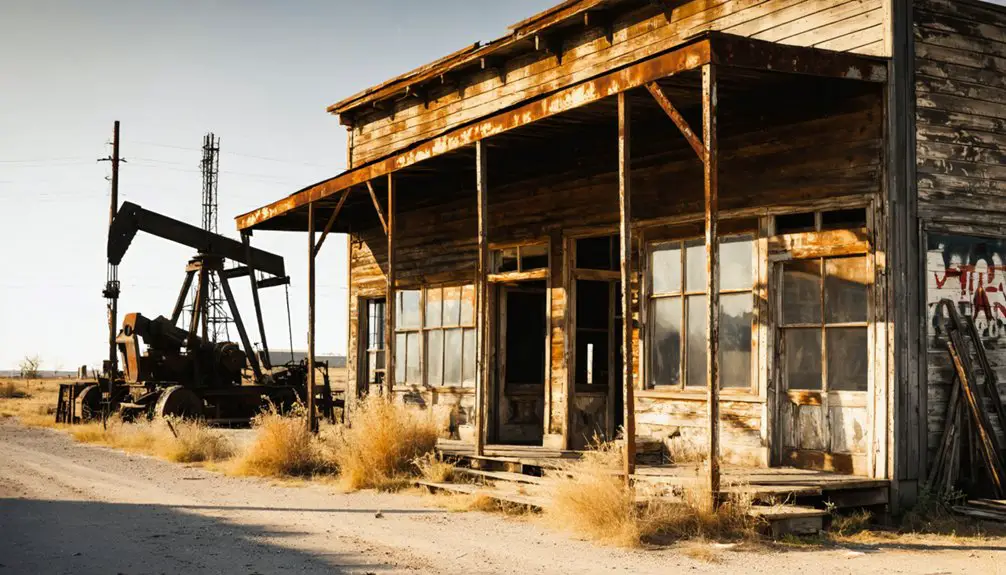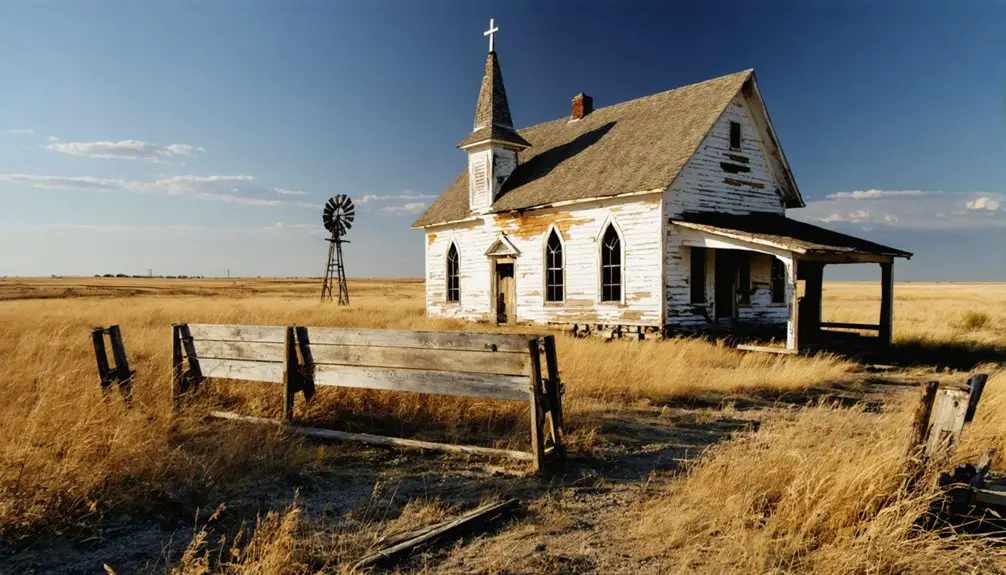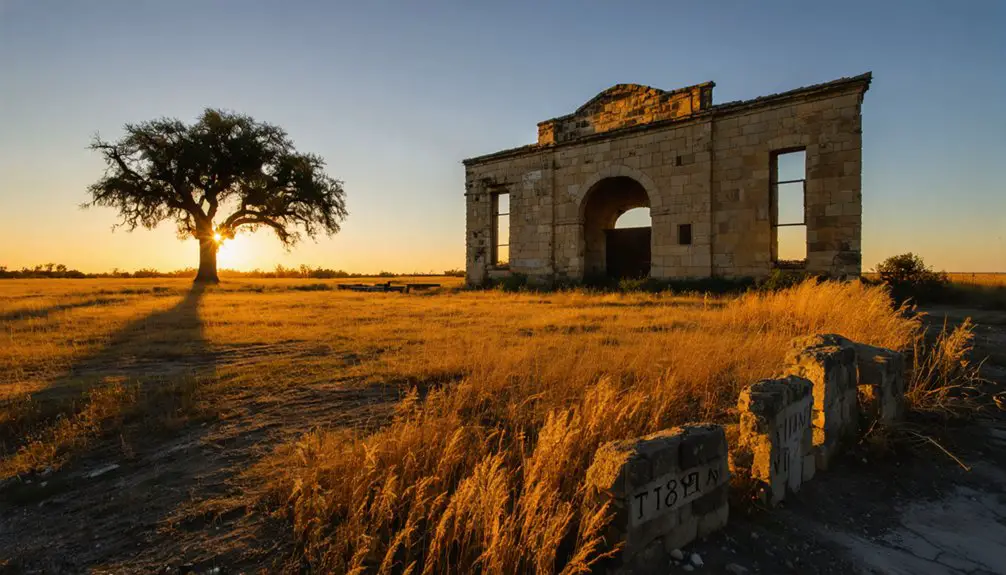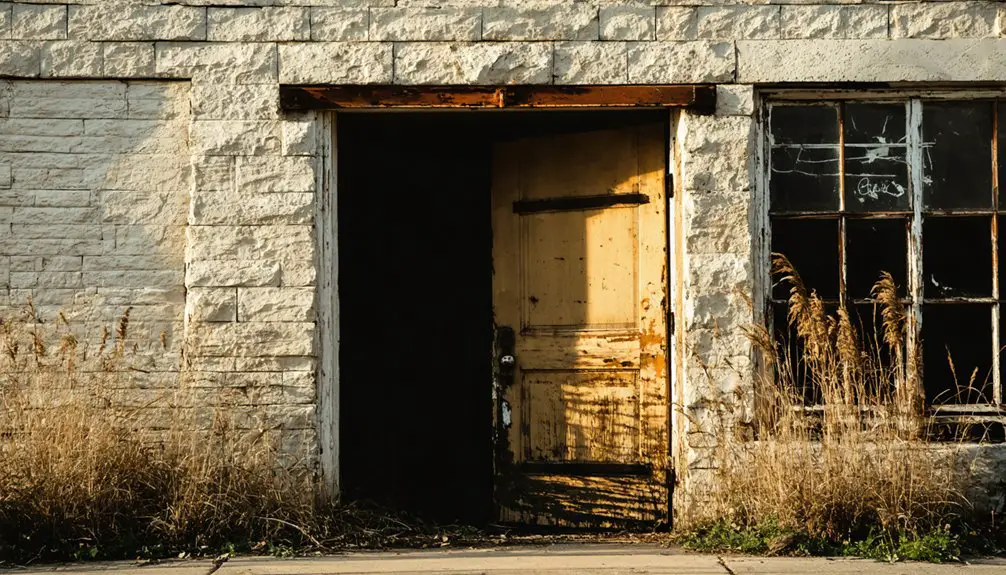You’ll find the haunting ruins of Belle Plain, Texas, in Callahan County, where this ambitious frontier town briefly flourished from 1876 to 1895. Founded with dreams of education and progress, Belle Plain reached its peak as a county seat with 400 residents, a prestigious college, and a bustling commercial district. After losing its county seat status and missing essential railroad connections, the town’s rapid decline left behind stone remnants and a historic cemetery filled with fascinating tales.
Key Takeaways
- Founded in 1876 as Callahan County’s seat, Belle Plain developed rapidly with a college, businesses, and peak population of 400 residents.
- The town declined after losing county seat status to Baird in 1884, leading to business closures and population exodus.
- Belle Plain’s post office closed in 1907, marking the final stage of its transformation from bustling frontier town to ghost town.
- Only ruins remain today, including foundations of the Methodist college and historic cemetery with marble headstones of early Texas pioneers.
- The abandoned town site attracts paranormal enthusiasts due to reported ghost sightings and legends of an ancient Native American burial ground.
The Birth of a Frontier Dream
While many frontier towns emerged through organic settlement, Belle Plain’s birth in 1876 reflected a purposeful vision centered on education and civic development. You’ll find its origins in Nelson M. Smith’s strategic purchase of state school land, where he planned to establish both a thriving community and a prestigious college.
Despite the settlement challenges of the remote Texas frontier, Belle Plain quickly attracted pioneers drawn to its education aspirations and political promise. Within a year, it became Callahan County’s seat, anchoring its importance in the region. The town’s growth included the establishment of Belle Plain College in 1881, marking a significant milestone in its educational mission. The institution became renowned for having the largest music conservatory between Fort Worth and El Paso.
Named after Katie Belle Magee, the first child born locally, the town soon boasted stores, saloons, a hotel, and its own newspaper. These early developments showcased the founders’ determination to build more than just another frontier outpost – they were crafting a cultural and educational hub.
A Promising Town Takes Shape
As Belle Plain secured its position as Callahan County‘s seat in 1877, the town’s infrastructure rapidly expanded beyond its educational foundations.
You’d have found founding families establishing multiple stores, saloons, and a local newspaper, while early commerce thrived around a bustling hotel.
The crown jewel of development was the Methodist college, built from native stone with impressive architectural features including a three-story structure topped by an elaborate cupola.
The college’s reputation for music education grew as its orchestra and brass band gained recognition.
At its height, the town reached a population of 400 residents.
The town later transformed during the 1920s when oil and gas discoveries sparked rapid economic changes.
You would’ve witnessed a town that contemporary observers praised as pleasant and beautiful, with observers in 1879 declaring it one of West Texas‘ most promising settlements, brimming with ambition and regional importance.
Life in Early Belle Plain
If you’d visited early Belle Plain, you’d have found a bustling frontier town with multiple stores, saloons, and essential services like hotels and drugstores serving the local population.
Pioneer life centered around these establishments where residents conducted daily business, bought supplies, and socialized with neighbors. The town’s commercial buildings and gathering spots formed the backdrop for community activities, though some establishments, like the saloons, also hosted less savory pursuits including gambling and bootlegging operations. The town’s rapid decline led to its complete abandonment and status as a ghost town by 1895.
The presence of Belle Plain College made the town particularly notable as an educational center in West Texas.
Frontier Buildings and Stores
Frontier life in Belle Plain centered around a mix of wooden and stone buildings that served the growing community’s needs. You’d have found most structures built from wood, including stores, saloons, and a hotel that catered to the town’s early settlers.
While these wooden structures eventually succumbed to time, the town’s most impressive buildings were crafted from native stone – particularly the Methodist college and dean’s home.
The three-story college, crowned with a distinctive fourth-story cupola, stood as Belle Plain’s architectural masterpiece. You can still find ruins of these stone buildings today, though they’re on private property.
The town’s commercial district once bustled with drugstores, general merchandise shops, and two cafes during the oil boom, supporting the region’s farming, ranching, and oil industries.
Daily Pioneer Activities
Dawn broke early for Belle Plain’s hardy pioneers, who balanced demanding agricultural work with the town’s growing industrial pursuits. Your daily routines would’ve revolved around agricultural practices, from tending cotton and wheat fields to managing cattle herds from sunup to sundown.
As oil wells emerged, you’d have witnessed the town transform, with many switching between farming and industrial labor at the carbon black plants.
- You’d start your day before sunrise, joining ranch hands and farmers in the fields, following the rhythm of seasonal planting and harvesting.
- Your workday might shift between traditional farming duties and the demanding schedule of oil field operations.
- You’d participate in community gatherings at the local church or school, where education and social bonds strengthened the pioneer spirit.
Community Social Gatherings
Social life in Belle Plain revolved around diverse gathering spots that shaped the town’s vibrant community spirit. You’d find residents forging community connections at local saloons, cafes, and churches, where they’d share news and engage in collective worship.
The town’s social dynamics flourished through school events, theatrical plays, and Belle Plain College’s cultural gatherings, which brought together people from all walks of life.
Local dances and musical performances created recreational opportunities, while political meetings maintained civic engagement. You could catch up on town gossip at drugstores and barbershops, where casual conversations flowed freely.
Even during Prohibition, when Sheriff Logue cracked down on bootlegging and gambling, residents found ways to maintain their social bonds through both legal and clandestine gatherings.
The Oil Boom Years

You’ll find that Belle Plain’s fortunes drastically changed when oil wells were discovered in the area during Texas’s transformative petroleum boom of the early 1900s.
The sudden influx of oil wealth brought rapid economic expansion to Belle Plain, mirroring the explosive growth seen in other Texas boomtowns like Beaumont and Borger. The town’s growth followed the statewide pattern of cheap fuel revolutionizing transportation and industrial development across Texas. Like many boomtowns of the era, workers faced poor living conditions with makeshift housing and unsanitary facilities.
A carbon black plant’s operations further cemented the town’s shift from its agricultural roots to an oil-based economy, though this prosperity would prove temporary.
Sudden Economic Growth Surge
The discovery of oil near Belle Plain triggered an unprecedented economic surge that transformed the quiet Texas town into a bustling boomtown.
You’d find the economic transformation evident in the rapid emergence of support businesses catering to the influx of oil workers. The boomtown dynamics created a largely male population, with workers living in makeshift housing and temporary structures. Similar to other oil towns across early 1900s Texas, the region was predominantly rural before petroleum discovery sparked rapid industrialization. The town experienced dramatic growth similar to Beaumont, where the Spindletop strike had initiated the Texas oil boom.
- Hotels, cafes, drug stores, and barber shops quickly sprouted up to serve the growing workforce.
- Entertainment venues and vice industries flourished, though they contributed to increased lawlessness.
- The town’s infrastructure struggled to keep pace, with unpaved streets turning to mud during rainfall.
Despite the challenges of rapid growth, Belle Plain’s oil-driven expansion mirrored the broader Texas boom that would eventually make the state a global petroleum powerhouse.
Oil Well Discoveries
While early oil exploration near Belle Plain began modestly in the late 19th century with small-scale wells producing around 10 barrels daily, the region’s petroleum industry wouldn’t reach its full potential until the 1930s East Texas Oil Boom.
You’ll find that drilling technology advanced dramatically during this period, evolving from basic steam-powered equipment to sophisticated rotary and cable-tool methods that could reach depths of thousands of feet.
The game-changing discoveries nearby, like the Lou Della Crim well flowing 22,000 barrels per day and Gregg County’s impressive 18,000-barrel daily output at 3,587 feet, sparked intense interest in Belle Plain’s potential.
These technological breakthroughs, combined with new geological mapping of salt domes and the Woodbine formation, transformed the region’s oil exploration landscape.
Carbon Black Plant Operations
During Belle Plain’s oil boom years around 1929, two bustling carbon black plants emerged as industrial anchors, capitalizing on the region’s abundant natural gas resources.
These plants used production methods involving hundreds of gas jets burning simultaneously under low oxygen conditions, extracting valuable black powder from heavy hydrocarbons.
- Plants operated in harsh conditions with workers facing constant exposure to airborne black powder
- The facilities processed casinghead and residue gas that contained hydrogen sulfide
- Carbon black production became essential for manufacturing synthetic rubber and automobile tires
You’ll find that Belle Plain’s carbon black operations were part of Texas’s larger industrial dominance, as the state produced up to 82% of the nation’s carbon black by the early 1930s.
The industry brought significant economic activity to the area, though working conditions remained challenging due to limited safety regulations.
Decline and Desertion

Once Belle Plain lost its coveted county seat status to Baird in 1884, the town’s decline accelerated rapidly.
Economic factors and transportation shifts dealt devastating blows to this once-promising settlement. You’ll find that Belle Plain’s isolation from major railroad lines proved particularly fatal, as commerce and residents gravitated toward Baird’s railway connections.
The town’s prosperity evaporated as businesses shuttered or relocated, and its population of 400 dwindled sharply.
By the early 1900s, you’d have witnessed a mass exodus of residents seeking better opportunities elsewhere. The post office’s closure in 1907 marked the final chapter of Belle Plain’s viability.
Today, you’ll see only scattered ruins on private property, silent testimonials to how quickly a frontier town’s fortunes can change when bypassed by progress.
Legends of Belle Plain Cemetery
Though Belle Plain itself has largely vanished, its historic cemetery remains a focal point for both paranormal enthusiasts and history buffs.
You’ll discover a rich tapestry of cemetery folklore spanning nearly 150 years, with the most compelling tales centered around ghostly encounters near the grave of a woman who allegedly hanged herself over her lover’s final resting place.
- Reports of Bigfoot-like creatures and strange knocking sounds have emerged from the cemetery’s east side, particularly during late-night investigations around 3 a.m.
- Local legends speak of an ancient Native American burial ground behind the cemetery, though it lacks archaeological verification.
- The 2.5-acre grounds, established in 1878, feature historical markers and imported marble headstones that tell the stories of early Texas pioneers.
Preserving Belle Plain’s Legacy

While Belle Plain’s physical structures have largely faded into Texas history, dedicated preservation efforts continue through a delicate balance of private stewardship and historical documentation.
You’ll find the site’s legacy carefully guarded by local landowners who prioritize protecting the remaining ruins from vandalism and unauthorized access.
Though you can’t visit the physical site, you can explore Belle Plain’s rich history through heritage education initiatives at regional museums and historical societies.
Experience Belle Plain’s captivating past through local museums and historical societies, where its heritage lives on despite restricted site access.
Community engagement keeps the ghost town’s story alive through archived newspapers, documented oral histories, and digital platforms.
Local educators use Belle Plain as a compelling case study of Texas settlement, westward expansion, and boom-to-bust development.
While the cemetery remains the only maintained historical marker, the town’s fascinating story endures through carefully preserved records and ongoing historical research.
Frequently Asked Questions
What Role Did Native Americans Play in Belle Plain’s History?
In 1874, when 100% of Comanche tribes were driven out, you’d see tribal interactions shift from dominance to displacement. Before Belle Plain’s founding, Native American cultural influences shaped regional trails and settlement patterns.
Are There Any Remaining Structures Still Standing in Belle Plain Today?
You’ll find two main remaining buildings: the stone-built Belle Plain College with its distinctive fourth-story cupola, and the dean’s residence. Both structures stand as enduring architectural features despite their deteriorating condition.
What Was the Total Population of Belle Plain at Its Peak?
During the peak years of rapid population growth in the 1880s, your frontier town reached approximately 400 residents, though one less credible source suggests 1,000 – the lower figure’s better supported historically.
Did Any Famous Historical Figures Ever Visit or Live in Belle Plain?
You won’t find any famous visitors or historically significant figures documented as having lived in or visited Belle Plain during its existence as a frontier and oil boom town.
What Caused the Carbon Black Plants to Eventually Shut Down?
You’ll find that economic decline, stricter environmental regulations, depleted natural gas resources, and industrial changes forced carbon black plants to close as newer, more efficient facilities emerged elsewhere with better technology.
References
- https://texashighways.com/travel-news/four-texas-ghost-towns/
- https://www.texashauntedhouses.com/real-haunt/belle-plaine-cemetery.html
- https://fridaycemeterysociety.wordpress.com/2012/09/17/the-ghost-town-of-belle-plain-texas/
- https://www.dumasmuseumandartcenter.org/belle_plain.html
- https://www.youtube.com/watch?v=gj5oGkywuoU
- https://www.tshaonline.org/handbook/entries/belle-plain-tx-callahan-county
- https://www.texasescapes.com/TexasTowns/BellePlainTexas/BellePlainTexas.htm
- https://www.tshaonline.org/handbook/entries/belle-plain-tx-moore-county
- https://en.wikipedia.org/wiki/Belle_Plain
- https://koolfmabilene.com/belle-plain-a-ghost-town-near-abilene/



